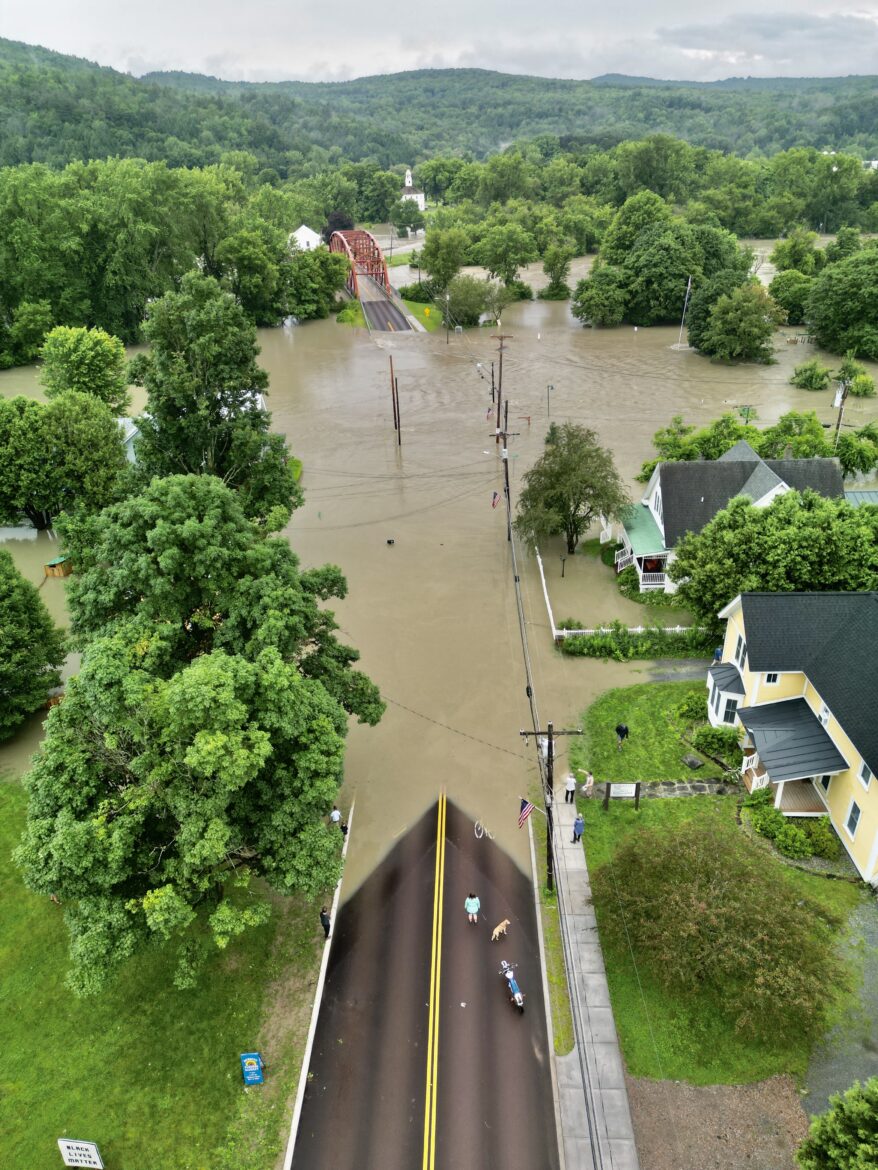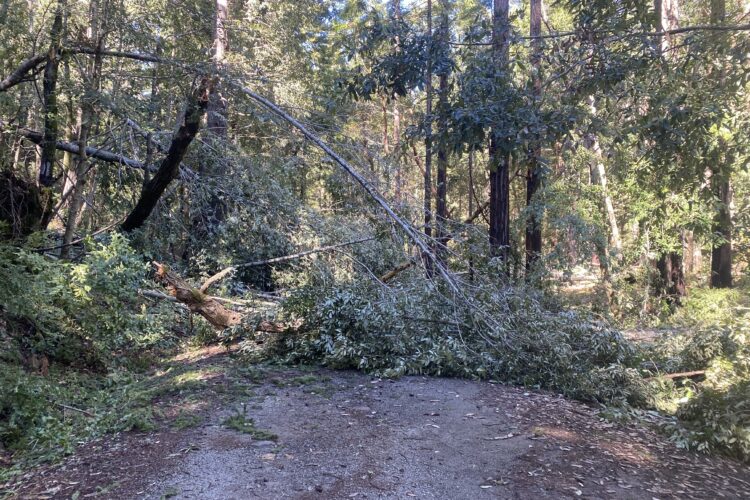
Just four weeks ago, a slow moving storm rolled across Vermont, dumping over nine inches of rain throughout the state. The torrential rainfall equaled about two months’ worth of water, which poured across already saturated ground. Rivers flooded, roads washed out, land slid, and many homes and businesses were devastated. Fortunately, there was just one confirmed fatality and, for mountain bikers, Vermont’s trail systems did not suffer the destruction that affected many residential areas and towns. As waters receded, Vermont mountain bikers banded together to assist local communities and, although triage is done, are now addressing trail damage with focused work events and fundraising.
Vermont Mountain Bike Association (VMBA) Executive Director Nick Bennette wants mountain bikers to know that Vermont is open for riding and open for business.
Modern mountain bike trail design helped save singletrack
“The vast majority of the 900 miles of trails that VMBA stewards in the state made out pretty well, mainly due to modern trail building techniques and water management,” he says. Bennette understands the priority for a disaster like this is community assistance. “People lost their homes, businesses and livelihoods. How do we support this?” VMBA directed messaging in the immediate aftermath to support local cleanup efforts and to fund local or state efforts such as the VT Flood Response & Recovery Fund 2023, which was able to raise millions of dollars to support individuals and businesses.
“Trails are important,” he says, “but in the first weeks, we wanted to make sure we weren’t stealing any spotlight for the response.” Now that FEMA has declared disaster and the community’s needs are being met, VMBA will host events and fundraise for their own storm relief plus ramp up grant committees. “Ten of our 29 chapters have significant damage, and we want to make sure we address their needs,” says Bennette.
VMBA chapters hardest hit by the storm–including those based in Ludlow, Montpelier, Barre, Waterbury, Richmond, and Jamaica–agree that professionally planned and built trails at higher elevations fared best.
Jill Olson, Chapter President for the Montpelier Area Mountain Bike (MAMBA) chapter says, “Our trails are actually OK. We have a small recently completed singletrack system just outside town. They were built to shed water and they did. The trails that were in rough shape are the older multi-use trails that have been in the park for a while.” Olson’s reaction to images of downtown Montpelier being navigated by canoe or kayak was that it made the flooding seem “quaint,” while the reality of the aftermath was horrific. “What flooding really looks like is mountains and mountains of garbage. Everyone’s stuff is just out on the street.”

Olson says MAMBA and the local mountain bike community focused volunteer efforts downtown, especially on their bike shop, Onion River Outdoors, which was completely devastated along with every other business. “For Montpelier, it’s less about the trails and more about the bike shop and the community that goes with it. We didn’t call for volunteers, people just showed up to help clean up.”
Resilient, creative business owners have relocated to sell salvaged inventory at the Saturday Farmer’s Market, which also moved to higher ground while downtown is refurbished.
“It’s a tight knit community, says Olson. “Mountain bikers have a very personal connection to the bike shop, so this feels personal. That’s why there’s so much energy to help them get back on their feet.” MAMBA plans to stick to their regular schedule. “Recreation is part of our recovery as a community. We are going to ride our local system and have a trail workday as planned.”
“Our trail network was largely spared when it came to catastrophic flooding because most of our trails are at a decent elevation,” says Darius Long, board member and co-chair of the Summer Trails Committee for Ascutney Trails Association.
“Given the excessive rainfall this summer, we have experienced a great deal of washout, stripping dirt from our trails, as well as water retention and mud from oversaturation. Our new skills park did suffer about $3,100 in damage but with timely work from our trail building contractor, Powder Horn Trail Co., and a slew of volunteers, we were able to get over 90% of our network open for the Flow State MTB Festival last weekend. We’re immensely proud of and grateful for our volunteers who helped make that possible.”

Nick Mahood is a Woodstock Area Mountain Bike Association (WAMBA) board member and Director of the Woodstock Inn’s Nordic Ski and Summer Outdoor Centers. He works with WAMBA to oversee mountain bike trail maintenance on the resort property. He says that while the trails were wet enough to be closed for several days, they fared well. WAMBA mobilized volunteers to remove downed trees, fix drainage and repair boardwalks. However, almost all the culverts on Mount Peg’s ski trails failed. This impacts singletrack connectivity on the mountain as they make repairs likely to take two months. While trails are rideable, temporary reroutes are necessary.
More moisture still means more damage
Like the rest of the country, bad weather patterns are hovering over regions and it’s still raining excessively in Vermont. Ridgeline Outdoor Collective (ROC) in the heart of the Green Mountains has three trail networks. Executive Director Angus McCusker says continued storms and rain in Vermont exacerbate destruction.
“Grounds are super saturated so an intense thunderstorm can do a lot of damage. Just this past Thursday night we received 2-5” of rain, causing landslides and road closures. We’re constantly assessing and cleaning up after storms this summer.” McCusker says their local volunteers “have really stepped up to the plate to get our trails back online,” logging 100+ hours in July. “For a small but fierce crew of trail stewards, that’s a lot for summer, when we generally don’t do much trail work.”
According to Bennette, only about 40% of VMBA’s natural surface trails saw major impacts from the storm, but continued rain is not helping. He estimates total VMBA damage to be worth around $50K. Past experience with devastating weather encouraged VMBA to plan for it. Several years ago, a freak windstorm devastated Stowe’s popular Cady Hill trail system. Cleanup of hundreds of downed trees cost a significant amount and led VMBA leadership to establish a Major Storm Recovery Fund. While the fund only had about $15K in early July, it does provide immediate assistance for events like the flooding. He adds, “People can donate directly to this fund on our website, and we can quickly deploy these dollars to get trail networks up and running.”


It’s still a good time to visit Vermont
Bennette says the current message across the state, from outdoor and tourism businesses to VMBA and other stewardship organizations, is uniform: “Vermont is still very much open. Many of our trails are open and riding fine. The last thing we want is for people to cancel their trips during our peak season. The caveat is that it’s critical to be extra thoughtful when visiting. We have a trail conditions page. The idea is ‘know before you go’…. Ask yourself, ‘Is where I’m going open? Are they ready for visitors?’ But understand that most of the state is in pretty good shape.”
Volunteers interested in trail restoration should find organized trail days on the VMBA events calendar (and posted by chapters) rather than just showing up to your favorite trail system.
“There’s always a demand but each chapter will need hands-on cleanup help for the next few weeks,” says Bennette. “That will go a long way to help getting everything up and running as fast as possible.”
How to help:
- VMBA 2023 Flood Response and how to help
- VMBA Major Storm Recovery Fund
- Vermont Trail Conditions
- VMBA Instagram





















1 Comments
Aug 15, 2023
Down in the mid-atlantic, the last time we had rain like that was probably hurricane Floyd, and we spent *months* afterward on my local trails repairing and rebuilding bridges (some of which we never found), shoveling sand and cutting uprooted trees.